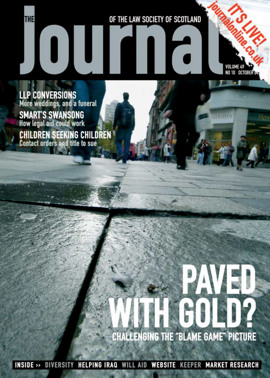Political correctness or positive change?

The term “Diversity” is becoming commonplace in the media, management-speak and, indeed, the legal world. Many, however, may still be unsure as to what the term really means and connotations may range from the positive to the unprintable.
What is it all about?
I have often found that when speaking to people about any diversity issue they are nervous about what language to use. Should we be saying black people, people of colour, ethnic minority groups, minority ethnic groups, disabled, the disabled, people with disabilities, women, females, lassies, hens, homosexuals, gay people? People often appear hindered from discussing issues by being embarrassed about not knowing the correct language, not knowing the issues, and not feeling able to ask for more information. But you can’t manage something you don’t talk about. To me, above everything, diversity is about acknowledging, exploring, understanding, respecting, and drawing strength from difference. Occasionally getting the language wrong is much more forgivable to all interested parties than head-in-the-sand-ism – which is why the Society has committed to raising the profile of diversity.
In the past much of the discussion of these issues was under the heading of “equal opportunities” and the emphasis was on legal compliance, selected functions of an organisation (e.g. recruitment and selection), punishment for non-compliance (be it through an internal equal opportunities policy or an employment tribunal), and treating everyone the same (rather than looking at outcomes, for example whether complainers from all ethnic groups have the same level of satisfaction with the complaints process). This is an important pillar of diversity but it is accompanied by a far more aspirational outlook, one that is also in many ways more realistic. Diversity is about recognising difference, integrating this throughout the whole organisation, and stressing the benefits.
Striving for “excellence” rather than compliance can seem a luxury, suitable for large and profitable commercial organisations but not professional bodies operating on subscriptions. So why do I, personally, see diversity as an essential part of management?
The argument is generally framed in three areas: the legal case, the business case, and the moral case. All are applicable to the responsibilities of the Society that also fall into three categories: regulator, employer, and service provider (to the public and profession).
The legal case
Writing on diversity in a publication for lawyers, it seems only right to start with the legal case. It is worth remembering that whilst diversity is a relatively recent paradigm, equal-opportunities-type legislation is not. For example, the Tolerance Acts (in Scotland and England) of the 1680s dealt with circumstances brought about by religious divide, and in 1833 Westminster legislated to forbid racial and religious discrimination in the Indian Civil Service. The practicalities of diversity are not “absolutes” but are dependent on the era in which they are set. Hence the legal argument overlaps with the moral/ethical one since the law will be infused with these preconceptions. This is certainly the case in the modern legislation covering sex, gender reassignment, race, disability, sexual orientation, religion and belief, and (in the near future) age. Additional legislation deals with issues such as asylum and immigration, flexible working, equal pay, and educational provision (including universities) for people with special educational needs and disabilities.
Organisations need to take great care both to comply with regulations and stay up to date with current developments. Some of the Acts introduce specific requirements to take action (for instance, monitoring or ensuring access to services), whilst for others it is a case of avoiding breaching the regulations. In all instances there is a dual incentive of the threat of litigation and the consequences of negative media coverage. A body such as the Society (or indeed a profession in general) failing to comply is highly newsworthy and also likely to raise concerns at a governmental level – both having potentially serious consequences for the future. This creates a responsibility for the Society to minimise risk in this area.
The business case
Again we start with history. When the Romans conquered they tended to incorporate local custom and practice into their way of doing things. It helped trade, reduced the likelihood of uprisings, and enriched their own culture. In a similar vein Christian nations were grateful to Jews for the provision of banking services, and yet we only need to look at negative caricatures such as Shylock to see that, again, this was for utility and expediency rather than moral or ethical conviction. The fact is that elements of diversity have always made good business sense, even to the cynical and exploitative.
Benefits recognised and achieved by companies implementing diversity include: recruiting the best candidates, increased staff retention, lower sickness absence rates, increased return to work after pregnancy, higher staff morale, increased customer satisfaction, increased customer loyalty, increased repeat business, higher turnover, and higher profits. A good work environment improves all the staff factors, whilst understanding customer needs and meeting demands influences the bottom line.
Examples from the legal profession include firms who have appointed staff from a variety of backgrounds and have found this has opened up a new customer base to them (for example, an Asian solicitor attracting Asian business clients), firms who have developed expertise in a particular field (for example, Islamic banking) and become market leaders, or firms that have developed services for niche markets (for example, conveyancing and executry work for gay people who have sometimes felt uncomfortable discussing such matters).
The moral case
The legal and business cases are compelling but it is the moral and ethical considerations that underpin both. This is because it is very hard to “fake” diversity without actually embracing the moral dimension. Ensuring compliance and achieving the business rewards is impossible if staff and customers/clients cannot see a real commitment to the principles of diversity.
If we define “moral” as the judgment of goodness and badness, and “ethical” as the accordance with a set of principles that govern conduct, we can see the relevance of both. The morality argument is simple in essence: everyone deserves to be treated equally as an individual, free of stereotypes, generalisations, indignity, or unfair treatment. As with all grand ideals, the detail is complicated and tends to generate the arguments over whether this or that is treating equally or offering unfair advantage, arguments of the many versus the few, and the problems of comparing the positions of dissimilar groups and individuals. Nevertheless that cannot be used as an excuse to stop working towards it. No lesson is more powerful than when a critic of diversity, or their family, has a change of circumstance that places them in one of the groups traditionally covered by diversity. What was a waste of time, money and effort in pursuit of a political partisan ideology suddenly becomes the fight for survival, dignity and respect. The old native American saying of walking a mile in someone else’s moccasins is poignant in relation to diversity.
In terms of ethical issues the Society’s Council has already placed discrimination in the Code of Conduct for Scottish Solicitors, and specifically notes “solicitors should be prepared to observe not only the letter but also the spirit of the anti-discrimination legislation”. Indeed, it appears only an extension of the founding motto of the Society, Humani Nihil Alienum (none of humanity’s problems are strange to us) – a professional openness and tolerance to those seeking recourse to justice, linked with an openness to a diverse profession.
What is the Society doing?
The Society has created a one-year plan to help us develop a thorough understanding of the issues and context of diversity. This includes raising awareness with Council and staff, training, establishing key performance indicators, setting up monitoring procedures, establishing an expert group to guide our work, and gathering information and evidence. However, if a key theme of diversity is trying truly to understand different perspectives then that necessarily means listening to what others think. Over the course of the year we will be using various techniques to gain the views of a wide range of groups and individuals. The Society is your professional body and I would encourage you to take part in these activities where you have the chance. The first stage of this will be a questionnaire coming out to the profession to provide vital data that will inform our work. The responses will be anonymous and, although some of the questions may seem somewhat personal in nature, I would ask everyone to return it. Ensuring we have an evidence base for what we do is ensuring that the profession can stand up to scrutiny in these issues – essential in an age of reviews such the Justice 1 inquiry into regulation, and Clementi – and that we target our effort most effectively.
The next stage is development of a three-year to five-year strategy and action plan that will co-ordinate our approach to diversity across all of our operations, ensuring compliance with legislation and driven by best practice.
Not just political correctness
All that is discussed here leads me to view and value diversity as so much more than the disappointing put-down of “political correctness”. In a modern organisation that is focused on meeting the needs of those to whom it provides services, diversity should be at the very heart. Ensuring that the organisation is legally compliant and risk is minimised is a core function of any management team, but even more than this, understanding the diversity of the profession and public we serve is the only way we can deliver high quality services that will also stand the test of public and governmental scrutiny. Diversity can be a positive change for all parties concerned and the Law Society of Scotland is determined to try to rise to the challenge.
Neil Stevenson would welcome feedback from anyone in the profession or beyond who is interested in becoming more involved in this work or who would like more information.
In this issue
- Citizenship, society and solicitors
- The well unfair state
- Litigation nation
- Best medicine
- Take a deep breath
- What title?
- Walk this way?
- Know your strategy
- e-quilibrium?
- The researchers
- Rights out of anarchy
- Political correctness or positive change?
- Steering clear
- How far can a board go?
- Major role for new tribunal
- The race is on (again)
- Planning a superhighway
- Website reviews
- Book reviews
- Single survey's lonely heart
- In harmony
- Clearing the path






